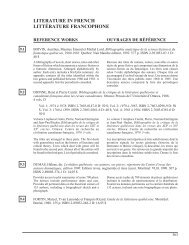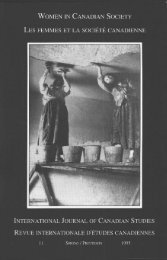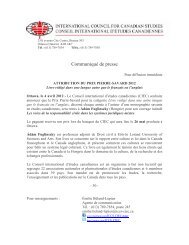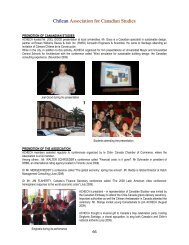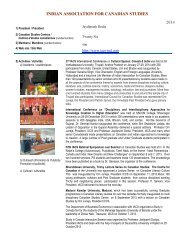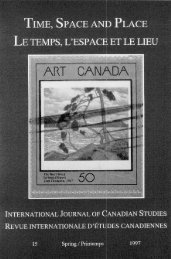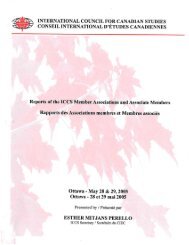Arts and Literature in Canada:Views from Abroad, Les arts et la ...
Arts and Literature in Canada:Views from Abroad, Les arts et la ...
Arts and Literature in Canada:Views from Abroad, Les arts et la ...
- No tags were found...
Create successful ePaper yourself
Turn your PDF publications into a flip-book with our unique Google optimized e-Paper software.
The Jordans. Remembered <strong>and</strong> Invented Pastworld of encyclopedias, just as Nelly distrusts Charlotte Jordan’s (she nevercalls her mother) pat proverbs <strong>and</strong> clichés both for moments of celebration <strong>and</strong>moments of disaster.Both girls strive to acquire a <strong>la</strong>nguage of their own. Nelly, irritated by theend<strong>in</strong>gs of fairy tales, would like to rewrite them, y<strong>et</strong> <strong>in</strong>stantly checks herself<strong>in</strong> much the same way that Munro’s hero<strong>in</strong>es, Del <strong>and</strong> Rose, f<strong>in</strong>d themselveschecked when show<strong>in</strong>g too much self assurance: “Who was she to f<strong>in</strong>d faultwith the end<strong>in</strong>gs of fairy tales?” (MC 89, my emphasis). Wolf’s phrase “Whowas she,” used <strong>in</strong> this context, does <strong>in</strong> fact correspond to the reprim<strong>and</strong> “Whodo you th<strong>in</strong>k you are?,” which Del encounters after she has l<strong>et</strong> down her friendNaomi (see LG 161) <strong>and</strong> which will <strong>la</strong>ter become the title <strong>and</strong> leitmotif of awhole story sequence, Who Do You Th<strong>in</strong>k You Are? Thus both writers use ast<strong>and</strong>ard phrase that will challenge the respective hero<strong>in</strong>e’s defiance aga<strong>in</strong>st aworld <strong>in</strong> which words are h<strong>and</strong>led carelessly. Apart <strong>from</strong> that, the questiondef<strong>in</strong>es, <strong>in</strong> the most economical way, both protagonists’ quest for autonomy<strong>and</strong> self reliance.Del, striv<strong>in</strong>g for a <strong>la</strong>nguage of her own, feels attracted by her aunts, <strong>in</strong> whosehouse “there was a whole new <strong>la</strong>nguage to learn” (LG 31). When Del’steacher, Miss Farris, a sp<strong>in</strong>ster both lovable <strong>and</strong> ridiculous, drowns <strong>in</strong> theWawanash River, Del is faced with the problem of “hang<strong>in</strong>g those picturestog<strong>et</strong>her” (LG 118), memories of farce <strong>and</strong> memories of tragedy, some of themdocumented, others distorted by <strong>in</strong>terpr<strong>et</strong>ation, a sum total of memory materialthat resists def<strong>in</strong>ition through <strong>la</strong>nguage. Then, f<strong>in</strong>ally, there is Del’s abortiveattempt at fus<strong>in</strong>g fact <strong>and</strong> fiction <strong>in</strong> a book about her hom<strong>et</strong>own, a fantasy <strong>from</strong>which she awakes with a shock, “[...] when you have dealt so cunn<strong>in</strong>gly,powerfully, with reality, to come back <strong>and</strong> f<strong>in</strong>d it is still there” (LG 209).Christa Wolf’s narrator expresses her desire to see “the structures ofexperience co<strong>in</strong>cid<strong>in</strong>g with the structures of the narrative, for fantasticaccuracy,” at the same time call<strong>in</strong>g such a desire “unsatisfiable, perhapsimpermissible.” Alice Munro’s narrator, at the end of the novel, expresses avery simi<strong>la</strong>r desire, y<strong>et</strong> worded very differently:[...] what I wanted was every <strong>la</strong>st th<strong>in</strong>g, every <strong>la</strong>yer of speech <strong>and</strong>thought, stroke of light on barks or walls, every smell, pothole, pa<strong>in</strong>,crack, delusion, held still <strong>and</strong> held tog<strong>et</strong>her — radiant, ever<strong>la</strong>st<strong>in</strong>g.(LG 210)But the emerg<strong>in</strong>g writer, the crafts woman <strong>in</strong> the protagonist, realizes that “thehope of accuracy” (LG 210) is illusory. Alice Munro had orig<strong>in</strong>ally p<strong>la</strong>nned togive Lives of Girls <strong>and</strong> Women the title Real Life. As a novel of the same titlehad just come out <strong>in</strong> the United States, the orig<strong>in</strong>al title had to be changed. 29Munro’s novel (if we disregard the m<strong>et</strong>afictional appendix “Epilogue: ThePhotographer”) ends with these words: “[...] I supposed I would g<strong>et</strong> started onmy real life. Garn<strong>et</strong> French, Garn<strong>et</strong> French, Garn<strong>et</strong> French. Real Life.“ (LG79



